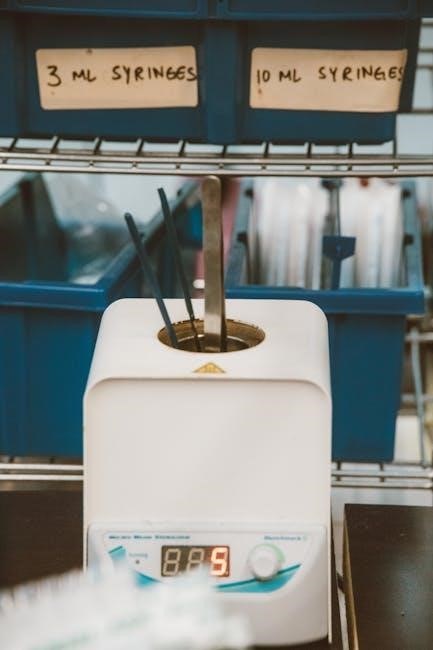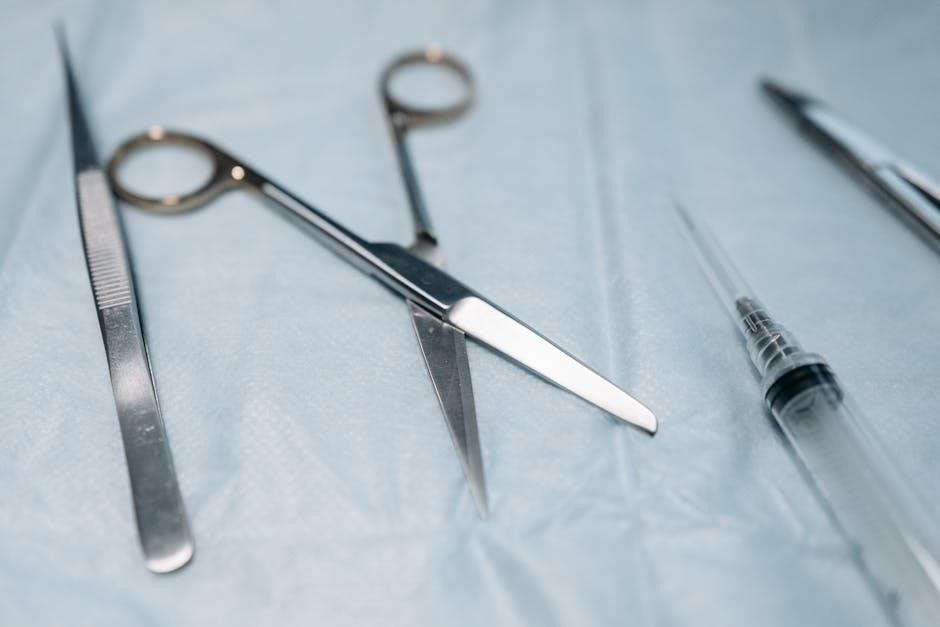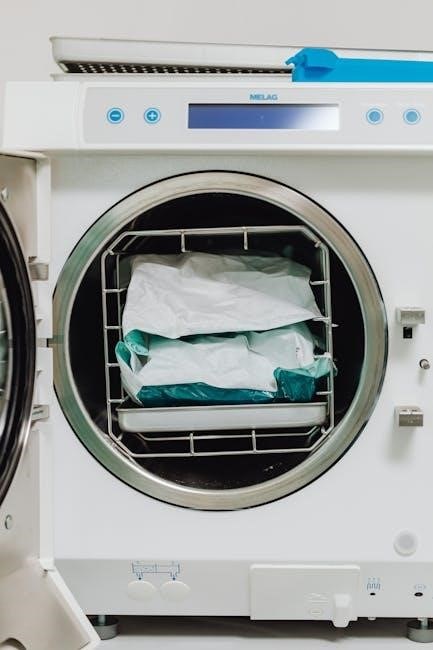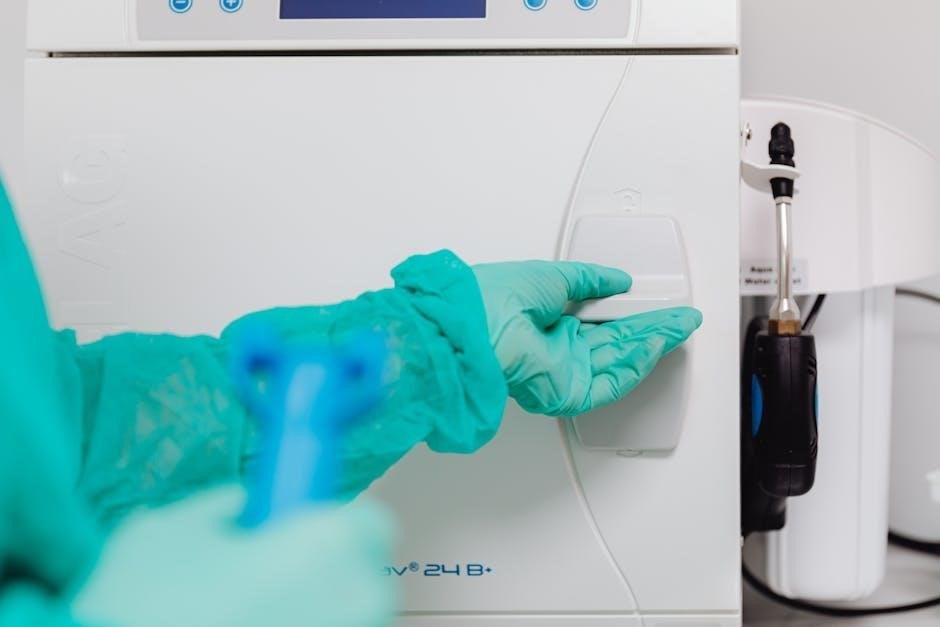
An autoclave is a device that uses steam under pressure to sterilize equipment. Essential for medical and lab settings‚ it ensures safety and efficiency. Proper usage is crucial for effectiveness and safety.
Understanding the Basics of Autoclave Operation
An autoclave operates by using steam under pressure to achieve high temperatures‚ effectively killing microorganisms. The process involves sealing the chamber‚ generating steam‚ and maintaining pressure until sterilization is complete. The autoclave cycle includes phases like pre-vacuum‚ steam injection‚ exposure‚ and venting.Steam sterilization is the most common method due to its efficiency and reliability. The autoclave ensures consistent temperature and pressure levels‚ critical for proper sterilization. Understanding these principles is essential for safe and effective use in laboratories‚ hospitals‚ and research settings.
Importance of Proper Autoclave Usage
Proper autoclave usage is critical for ensuring the sterilization of instruments and materials. It prevents contamination‚ which is essential for maintaining safety and integrity in medical and laboratory environments. Autoclaving ensures that all microorganisms are eliminated‚ reducing the risk of infections and experimental errors. It is also vital for compliance with health and safety regulations. Improper usage can lead to incomplete sterilization‚ potentially causing serious consequences. Regular maintenance and correct operation ensure optimal performance. Proper usage also extends the lifespan of the autoclave and the items being sterilized. Understanding and adhering to autoclave guidelines is fundamental for achieving reliable results and safeguarding both personnel and processes. This ensures a safe and efficient sterilization process‚ making it indispensable in healthcare and research settings.

Preparing Items for Autoclaving
Preparing items for autoclaving involves selecting appropriate materials and packaging them correctly to ensure proper sterilization. This step is crucial for achieving effective steam penetration and sterilization.
Choosing the Right Materials for Sterilization
Selecting the appropriate materials for autoclaving is essential to ensure effective sterilization and prevent damage. Glassware‚ certain plastics‚ and metal instruments are ideal for autoclaving‚ as they withstand high temperatures and steam. Materials like paper‚ cloth‚ and rubber can also be sterilized‚ but they must be compatible with steam exposure. Avoid using materials that melt‚ degrade‚ or react adversely to heat‚ such as polyethylene plastics or items with electrical components. Always verify the material’s suitability for autoclaving before proceeding. Proper material selection ensures safety‚ prevents contamination‚ and maintains the integrity of the sterilized items. Additionally‚ using autoclave tape on packages helps confirm successful sterilization‚ as the tape changes color when exposed to steam. This step is critical for maintaining sterility and operational efficiency in laboratory and medical settings.
Packaging Items Correctly
Proper packaging is critical for effective sterilization in an autoclave. Items should be wrapped in autoclave-safe materials‚ such as heat-resistant pouches or wrapped trays‚ to allow steam penetration. Use autoclave tape to secure packages and ensure they can withstand high temperatures and pressure. Avoid overcrowding the autoclave‚ as this prevents steam from circulating evenly. Place items in a single layer or use baskets to maximize exposure. Liquids and sensitive instruments require special packaging to prevent damage. Always leave space between packages for optimal steam flow. Ensure all containers are vented to allow steam to reach the contents. Proper packaging ensures sterility‚ prevents contamination‚ and safeguards equipment from damage during the cycle. Additionally‚ include autoclave indicators or biological controls to confirm successful sterilization. Correct packaging is essential for maintaining safety and efficiency in autoclaving processes.

Operating the Autoclave
Start the autoclave by selecting the appropriate cycle for your items. Ensure the chamber is properly loaded and sealed. Monitor the cycle progress and use controls to adjust settings as needed.
Step-by-Step Guide to Starting the Autoclave
Begin by powering on the autoclave and ensuring all safety features are activated. Press the green start button located on the front panel. If the lamp is already green‚ proceed to select your desired cycle. Choose the appropriate program based on the items being sterilized‚ such as liquid‚ solid‚ or waste. Once selected‚ load the items into the chamber‚ ensuring they are properly packaged and spaced. Close the autoclave door securely and initiate the cycle. The machine will automatically generate steam‚ heat‚ and pressure to sterilize the contents. Monitor the process through the control panel‚ which displays temperature‚ pressure‚ and time. Use autoclave tape to verify successful sterilization. Always follow manufacturer guidelines and safety protocols when operating the autoclave. Proper startup ensures efficient and safe sterilization of all items.
Monitoring the Autoclave Cycle
Monitoring the autoclave cycle is crucial to ensure sterilization effectiveness. Begin by observing the control panel‚ which displays real-time temperature‚ pressure‚ and time. Ensure the machine reaches the set parameters‚ typically 121°C and 15 PSI for standard cycles. Use autoclave tape or indicators to confirm sterilization. Listen for alarms or unusual sounds‚ as they may signal issues. Regularly inspect the steam generator and drain for blockages. After the cycle‚ allow the pressure to drop naturally before opening the door. Always wear protective gear when unloading items. Maintain a log of cycles for quality control. Proper monitoring ensures safety‚ efficiency‚ and compliance with sterilization standards. Address any irregularities promptly to prevent contamination or equipment damage. Consistent oversight guarantees reliable results in every autoclave cycle.

Safety Precautions
Always wear protective gear‚ including gloves and goggles‚ when handling autoclaved items. Ensure proper ventilation to prevent exposure to harmful vapors. Never open the autoclave prematurely‚ as hot steam can cause burns. Regularly inspect safety valves and ensure all features function correctly. Follow manufacturer guidelines strictly to maintain a safe working environment.
Ensuring a Safe Working Environment
To maintain a safe working environment when using an autoclave‚ always wear protective gear‚ such as gloves and goggles. Ensure the autoclave is placed in a well-ventilated area to prevent the buildup of harmful vapors. Regularly inspect the autoclave’s safety features‚ including pressure valves and seals‚ to ensure they are functioning properly. Never open the autoclave before the cycle is complete‚ as the contents may still be hot and under pressure. Follow the manufacturer’s guidelines for operation and maintenance to minimize risks. Additionally‚ train all staff on proper autoclave usage to prevent accidents. A safe environment not only protects personnel but also ensures the integrity of the sterilization process.
Handling Items Before and After Sterilization
Before sterilization‚ items must be properly prepared and packaged in autoclave bags or wrapped in cloth to prevent contamination. Place items in the autoclave basket‚ ensuring they are not overcrowded for even steam distribution. After the cycle‚ allow the autoclave to cool slightly before opening to avoid steam burns. Use heat-resistant gloves to remove items‚ as they may still be hot. Check for autoclave tape or indicators to confirm successful sterilization. Store sterilized items in a clean‚ dry environment to maintain their sterility. Proper handling prevents re-contamination and ensures the effectiveness of the sterilization process. Always follow manufacturer guidelines for specific item requirements. This step is critical for maintaining safety and efficiency in laboratory or medical settings.

Maintenance and Troubleshooting
Regular cleaning every 25-30 cycles and calibration with NIST-traceable devices ensure optimal performance. Address common issues like faulty sensors or seal problems promptly to maintain efficiency and safety.
Regular Maintenance for Optimal Performance
Regular maintenance is critical to ensure the autoclave operates efficiently and safely. Cleaning the chamber and drain lines every 25-30 cycles prevents residue buildup. Use a recommended autoclave cleaner to maintain hygiene and functionality. Additionally‚ calibration using NIST-traceable devices‚ such as temperature probes‚ ensures accuracy. Check door seals and gaskets regularly for wear and tear‚ replacing them as needed to maintain pressure integrity. Descale the autoclave periodically to remove mineral deposits‚ which can affect performance. Lubricate moving parts to prevent friction and extend the lifespan of the device. Finally‚ schedule professional servicing annually to address complex issues and ensure compliance with safety standards. By following these steps‚ you can extend the autoclave’s lifespan and maintain reliable sterilization results.
Identifying and Resolving Common Issues
Common autoclave issues include pressure leaks‚ temperature fluctuations‚ and sensor malfunctions. These problems can disrupt sterilization processes and affect overall performance. Diagnosing these issues involves checking for signs like incomplete cycles‚ unusual noises‚ or error messages. Regular maintenance‚ such as cleaning the chamber and drain lines‚ can prevent residue buildup. Inspecting door seals and gaskets for wear and tear helps maintain pressure integrity. If a pressure leak occurs‚ ensure all connections are secure and replace worn seals. For temperature fluctuations‚ verify heating elements and sensors are functioning correctly. Malfunctioning sensors may require recalibration or replacement. Additionally‚ descale the autoclave periodically to remove mineral deposits and lubricate moving parts to prevent friction. Addressing these issues promptly ensures optimal performance‚ safety‚ and reliable sterilization results‚ extending the autoclave’s lifespan and maintaining efficiency.